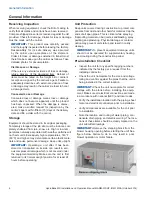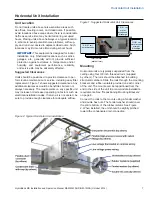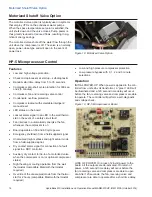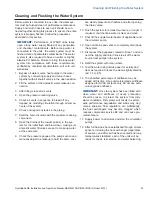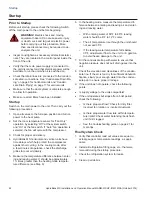
HydroBank MS Installation and Operation Manual MAMM-WSHP-IOM-1MSA (October 2014)
17
HP-5 Microprocessor Control
RANDOM START: A 5 to 35 second time delay of fan,
reversing valve and compressor operation will occur
each time the unit comes off shutdown mode, unoc-
cupied mode and low/high voltage mode. The random
start time varies each time it is activated; for example,
the time delay may be 5 seconds, then 12, then 30, then
17, then 32, then 6, etc.
Note: The following descriptions assume Initial Power-
up and Random Start functions have occurred.
FAN OPERATION: On a call for fan operation from the
wall thermostat “fan on” switch or from a call for com-
pressor operation, fan operation is delayed for 2 sec-
onds.
REVERSING VALVE: On a call for cooling from the
wall thermostat, the reversing valve is energized after
4 seconds. Once the cooling demand is satisfied, the
reversing valve is held on for 4 seconds before it is de-
energized.
COMPRESSOR OPERATION: On a call for cooling
or heating from the wall thermostat, the compressor is
energized from the compressor output terminal after 6
seconds. Once the call for cooling or heating is satis-
fied, the compressor shuts off immediately. At that time,
a 300 second (5 minute) timer begins to prevent the
compressor from re-starting even though the wall ther-
mostat may again call for cooling or heating. During this
300 second interval, the compressor will not be allowed
to restart. After the 300 second time delay elapses, the
compressor is allowed to start if the wall thermostat calls
for cooling or heating.
FAN INTERLOCK OPERATION: When compressor
operation is required, the fan is automatically enabled 4
seconds before the compressor, even if the wall thermo-
stat is not calling for fan operation. This makes sure the
fan will be on whenever the compressor is on.
SAFETY CIRCUIT OPERATION: The unit has up to 4
safety circuits to prevent the compressor from operating
during abnormal conditions.
•
High Pressure Switch: If the refrigerant pressure
exceeds the high pressure set-point, the high pres-
sure switch opens immediately and the unit goes
into the lockout mode
•
Low Pressure Switch: If the refrigerant pressure falls
below the low pressure set-point, the low pressure
switch closes immediately and the unit goes into
the lockout mode after the amount of low pressure
bypass has been satisfied.
•
Optional Freezestat Switch: If the leaving fluid tem-
perature falls to 32°F, the freezestat switch opens.
After 10 seconds, the unit goes into lockout mode.
•
Condensate Overflow Protection: If the drain pan
sensor comes in contact with moisture for more than
30 seconds, the unit goes into lockout mode.
LED STATUS:
•
ON
Normal operating mode
•
1 Flash
High pressure fault
•
2 Flashes Emergency shutdown mode
•
3 Flashes Freezestat switch
•
4 Flashes Condensate overflow fault
•
5 Flashes Low voltage fault
•
6 Flashes High voltage fault
•
7 Flashes Low pressure fault
LOCKOUT MODE: Lockout mode will occur if any of the
safety circuits are activated. In this condition the com-
pressor is de-energized, but the fan operates if the wall
thermostat is calling for cooling or heating. The two lock-
out alarm circuits are also enabled.
LOW AND HIGH VOLTAGE PROTECTION: If voltage
conditions are good, the unit performs a self-diagnostic
check for faults. If no faults are identified, the “green”
LED comes on with no flashes. If the supply voltage
falls below the minimum or above the maximum, the
reversing valve, fan and compressor are de-energized.
LED lights will indicate the fault. Once the voltage falls
within an acceptable range, the unit will restart without
requiring a reset. All time delays required for start-up of
the fan, compressor and reversing valve will take place
before the unit is re-started. The low voltage cut-out is
21.6 VAC and the cut-in is 24.0 VAC. The high voltage
cut-out is 34.0 VAC and the cut-in is 29.7 VAC. These
high and low voltages are monitored at terminals “R”
and “COM”.
LOCKOUT ALARM (CIRCUIT) SIGNAL: This is the first
lockout alarm circuit. In the lockout mode, the circuit
provides a 24-volt power (+) signal at the “LO ALM” ter-
minal of the terminal block which is wired to the LED on
the wall thermostat to indicate a lockout condition.
DRY CONTACTS LOCKOUT ALARM (CIRCUIT) SIG-
NAL: This is the second lockout alarm circuit. In the
lockout mode, this circuit provides a signal at the termi-
nal block. The signal is a set of normally open contacts
at terminals “IN ALM” and “OUT ALM” of the unit termi-
nal strip. The contacts close in the lockout mode, allow-
ing connection of a remote alarm.
RESET OF A LOCKOUT: The controller can be selected
to manual or intelligent reset of a lockout mode through
an on-board dip switch labeled as “RST”. When a man-
ual reset is selected, the unit stays in lockout until it is
manually reset by interrupting power or by removing the




